Potrebujeme váš súhlas na využitie jednotlivých dát, aby sa vám okrem iného mohli ukazovať informácie týkajúce sa vašich záujmov. Súhlas udelíte kliknutím na tlačidlo „OK“.
ASTM D6091-07(2014)
Standard Practice for 99 %/95 % Interlaboratory Detection Estimate (IDE) for Analytical Methods with Negligible Calibration Error (Withdrawn 2023)
Automaticky preložený názov:
Štandardná prax pre 99% / 95% Interlaboratory Detection Odhad (IDE) pre analytické metódy sa zanedbateľnú chybu kalibrácia
NORMA vydaná dňa 15.1.2014
Informácie o norme:
Označenie normy: ASTM D6091-07(2014)
Poznámka: NEPLATNÁ
Dátum vydania normy: 15.1.2014
Kód tovaru: NS-33737
Počet strán: 13
Približná hmotnosť: 39 g (0.09 libier)
Krajina: Americká technická norma
Kategória: Technické normy ASTM
Kategórie - podobné normy:
Anotácia textu normy ASTM D6091-07(2014) :
Keywords:
critical limit, detection, detection limit, false detection, false nondetection, false positive, matrix effects, statistical tolerance limit, true detection, true nondetection, ICS Number Code 17.020 (Metrology and measurement in general)
Doplňujúce informácie
| Significance and Use | ||||
|
5.1 Appropriate application of this practice should result in an IDE achievable by most laboratories properly using the test method studied. This IDE provides the basis for any prospective use of the test method by qualified laboratories for reliable detection of low-level concentrations of the same analyte as the one studied in this practice and same media (matrix). 5.2 The IDE values may be used to compare the detection power of different methods for analysis of the same analyte in the same matrix. 5.3 The IDE provides high probability (approximately 95 %) that result values of the method studied which exceed the IDE represent presence of analyte in the sample and high probability (approximately 99 %) that blank samples will not result in a detection. 5.4 The IDE procedure should be used to establish the interlaboratory detection capability for any application of a method where interlaboratory detection is important to data use. The intent of IDE is not to set reporting limits. |
||||
| 1. Scope | ||||
|
1.1 This practice establishes a standard for computing a 99 %/95 % Interlaboratory Detection Estimate (IDE) and provides guidance concerning the appropriate use and application. The calculations involved in this practice can be performed with DQCALC, Microsoft Excel-based software available from ASTM.1.2 The IDE is computed to be the lowest concentration at which there is 90 % confidence that a single measurement from a laboratory selected from the population of qualified laboratories represented in an interlaboratory study will have a true detection probability of at least 95 % and a true nondetection probability of at least 99 % (when measuring a blank sample). 1.3 The fundamental assumption of the collaborative study is that the media tested, the concentrations tested, and the protocol followed in the study provide a representative and fair evaluation of the scope and applicability of the test method as written. When properly applied, the IDE procedure ensures that the 99 %/95 % IDE has the following properties: 1.3.1 Routinely Achievable IDE Value—Most laboratories are able to attain the IDE detection performance in routine analyses, using a standard measurement system, at reasonable cost. This property is needed for a detection limit to be practically feasible. Representative laboratories must be included in the data to calculate the IDE. 1.3.2 Routine Sources of Error Accounted For—The IDE should realistically include sources of bias and variation which are common to the measurement process. These sources include, but are not limited to: intrinsic instrument noise, some typical amount of carryover error, plus differences in laboratories, analysts, sample preparation, and instruments. 1.3.3 Avoidable Sources of Error Excluded—The IDE should realistically exclude avoidable sources of bias and variation, that is, those which can reasonably be avoided in routine field measurements. Avoidable sources would include, but are not limited to: modifications to the sample, measurement procedure, or measurement equipment of the validated method, and gross and easily discernible transcription errors (provided there was a way to detect and either correct or eliminate them). 1.3.4 Low Probability of False Detection—The IDE is a true concentration consistent with a measured concentration threshold (critical measured value) that will provide a high probability, 99 %, of true nondetection (a low probability of false detection, α = 1 %). Thus, when measuring a blank sample, the probability of not detecting the analyte would be 99 %. To be useful, this must be demonstrated for the particular matrix being used, and not just for reagent water. 1.3.5 Low Probability of False Nondetection—The IDE should be a true concentration at which there is a high probability, at least 95 %, of true detection (a low probability of false nondetection, β = 5 %, at the IDE), with a simultaneous low probability of false detection (see 1.4 The IDE applies to measurement methods for which calibration error is minor relative to other sources, such as when the dominant source of variation is one of the following (with comment): 1.4.1 Sample Preparation, and calibration standards do not have to go through sample preparation. 1.4.2 Differences in Analysts, and analysts have little opportunity to affect calibration results (such as with automated calibration). 1.4.3 Differences in Laboratories, for whatever reasons, perhaps difficult to identify and eliminate. 1.4.4 Differences in Instruments (measurement equipment), which could take the form of differences in manufacturer, model, hardware, electronics, sampling rate, chemical processing rate, integration time, software algorithms, internal signal processing and thresholds, effective sample volume, and contamination level. 1.5 Alternative Data Quality Objectives—Other values forα, β, confidence, etc. may be chosen for calculating an IDE; however, this procedure addresses only the 99 %/95 % IDE. |
||||
| 2. Referenced Documents | ||||
|
Podobné normy:
Historická
1.4.2012
Historická
28.3.2013
Historická
28.3.2013
Historická
1.8.2013
Historická
1.3.2010
Historická
1.10.2008
Odporúčame:
EviZak - všetky zákony vrátane ich evidencie na jednom mieste
Poskytovanie aktuálnych informácií o legislatívnych predpisoch vyhlásených v Zbierke zákonov od roku 1945.
Aktualizácia 2x v mesiaci !
Chcete vedieť viac informácii ? Pozrite sa na túto stránku.


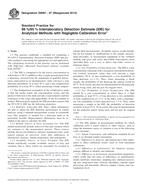
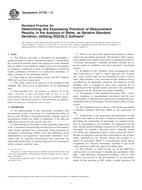 ASTM D7729-12
ASTM D7729-12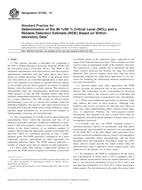 ASTM D7782-13
ASTM D7782-13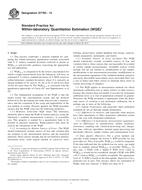 ASTM D7783-13
ASTM D7783-13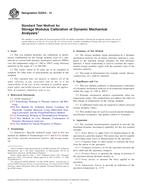 ASTM E2254-13
ASTM E2254-13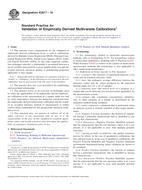 ASTM E2617-10
ASTM E2617-10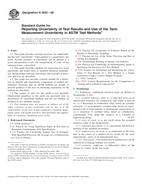 ASTM E2655-08
ASTM E2655-08
 Cookies
Cookies
